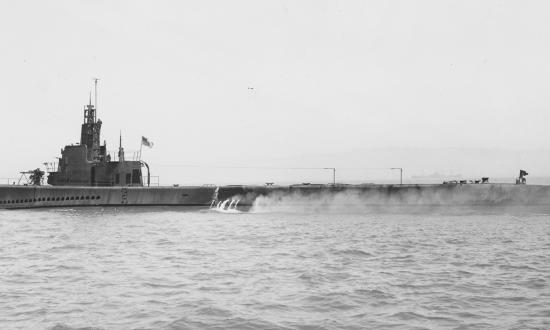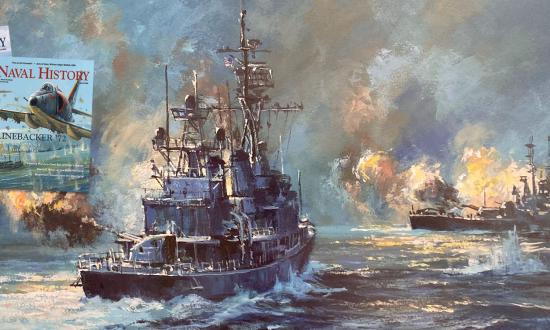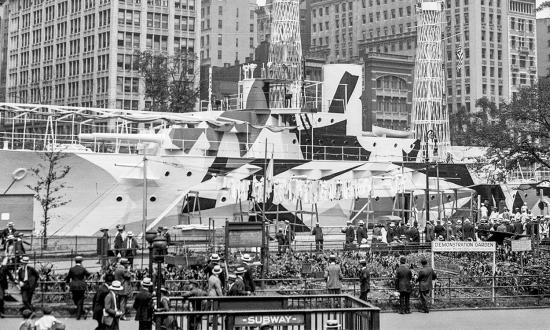Fresh Insights, from Casablanca to Tunisia
Robert S. Kaplan
Vincent O’Hara’s interesting and insightful articles on Operation Torch enhanced my naval education and were a major contribution to making this issue the best of the year. (“Destination: North Africa” and “Tough Race to Tunisia,” December 2022) Having read many decades ago Rear Admiral Samuel Eliot Morison’s account of the Naval Battle of Casablanca, I believed what the rear admiral had in his book was the final account of the battle. Mr. O’Hara’s modern scholarship has cast the battle in a new light—with Rear Admiral Robert C. Giffen making his dubious debut as a combat leader.
After North Africa, Rear Admiral Giffen was in the Pacific putting in an even more inept performance at the 29–30 January 1943 Battle of Rennell Island. This time an important ship was sunk, the heavy cruiser USS Chicago (CA-29), and the destroyer USS La Vallette (DD-448) was damaged. Giffen then was given a seagoing command in the Aleutians, where he played a role in the Battle of the Pips. Back to warmer Pacific waters he went, remaining at sea into 1944. He would retire as a vice admiral. I read somewhere that he was a favorite of Admiral Ernest J. King. Maybe that is what gave Giffen command immunity.
Concerning all those ships getting to Tunisia, where was the U.S. Navy? In 1942, the Allies were slow to react to the crisis, and the enemy arrived. In 1943, when thousands of Germans were escaping from Sicily to Italy, no major naval effort was made to stop them. Why? This time, the same mistake was made in reverse.
‘One of the Riskiest’ to Say the Least
Commander Chris Languel, USNR (Ret.)
As usual Mr. O’Hara provides an excellent, succinct narrative of the Casablanca action during Operation Torch. To say Torch was “one of the riskiest operations” may be an understatement. Task Force 34 and the reinforcing convoy, UGF-2 escorted by Task Force 38, contained nearly every heavy ship (four of four battleships, the only fleet carrier, four of five auxiliary carriers, every modern cruiser) along with every modern destroyer but one, ready for sea, assigned to the Atlantic Fleet. Even ships designated for the Pacific Fleet were added (see CINCLANT War Diary, November 1942, and Atlantic Fleet Weekly Operation Sheet, 4 November 1942). Nearly every transport that could sail was used. Only Task Force 23 (South Atlantic Force) with the old light cruisers and most of DesRon 9 (the large destroyer leaders without dual-purpose 5-inch/38s) remained relatively untouched.
Even then, a few elements escorted reinforcements part way to North Africa. This doesn’t even begin to cover the inexperience of most of the carrier pilots and crews in some of the more recently commissioned new construction.
To quote Rear Admiral Morison, “Task Force 34 resembled a football team forced to play a major game very early in the season, before holding adequate practice or obtaining proper equipment.” (History of United States Naval Operations in World War II, vol. 2, Operations in North African Waters, October 1942–June 1943, p. 33.)
Operation Torch: The Submarine Factor
Commander Tom Boyer, USNR (Ret.)
Thanks for the good article on Operation Torch. My father-in-law participated in Torch on board the USS Shad (SS-235) and earned his first Submarine Combat Insignia for its actions. The Shad was one of six submarines President Franklin D. Roosevelt had agreed with British Prime Minister Winston Churchill to counter the German U-boats off Britain.
It is worth pointing out the role that U.S. submarines played in advance reconnaissance during the invasion of Casablanca. The war report for the Shad notes:
Arrived off coast of Mehediya and sighted searchlights from Casablanca Harbor. Began soundings and movie filming of the harbor and breakwater. Used “special light” to signal approaching U.S. ships. Invasion of Mehediya began 8 November [1942] and Shad ordered to clear the area.
Other boats of SubRon 7 were the USS Barb (SS-220, later to become famous in the Pacific Theater), Blackfish (SS-221), Gunnell (SS-253, John S. McCain Jr. commanding), and Herring (SS-233). Four of the boats reported to the naval base at Rosneath, Scotland, but were soon transferred to the Pacific theater.
Tackling a ’70s Scourge
J. D. Koegel
As Chief of Naval Operations, Admiral Thomas Hayward deserves the highest possible praise for tackling head-on the drug culture present in the Navy at the time, and doing it in a realistic and constructive way. (“Not in My Navy,” October 2021)
As a proud and enthusiastic (and somewhat naïve) junior enlisted man in the early 1970s, it was surprising and disheartening to see firsthand the widespread drug misuse among some sailors of the day. That illicit drugs should have no place in an environment as demanding and unforgiving as a naval vessel at sea goes without saying.
Also of concern was the morale problem that drugs created. It wasn’t unusual for a young enlisted to be viewed as either a user or a “narc,” so great was the paranoia among some crew members.
A WestPac cruise in 1972 recalls many memories. Two of the most enduring were serving on board a ship participating in Operation Linebacker (see “Operation Linebacker: The Sea Power Factor,” August 2022, pp. 12–20), the other of standing midwatch in the engine room while riding out a typhoon—while being the only watch stander not strung out on drugs.
Correction: On pages 48–49 of the December 2021 issue, the ship’s name should be Sutherland, not Swiftsure.







